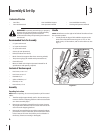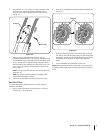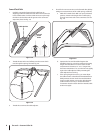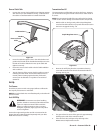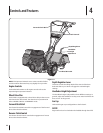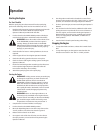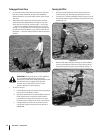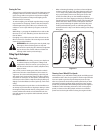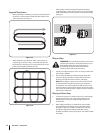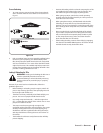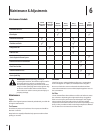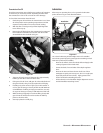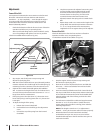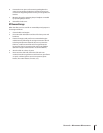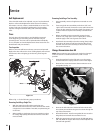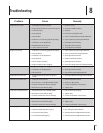
Suggested Tilling Patterns
When preparing a seedbed, go over the same path twice in
the first row, then overlap one-half the tiller width on the
rest of the passes. See Fig. 5-5.
When finished in one direction, make a second pass at
a right angle, as shown in Fig. 5-6. Overlap each pass for
best results (in very hard ground, it may take three or four
passes to thoroughly pulverize the soil.)
•
•
If the garden size will not permit lengthwise and then
crosswise tilling, overlap the first passes by one-half a tiller
width, followed by successive passes at one-quarter width.
See Fig. 5-7.
Tilling on a Slope
WARNING! Do not operate the tiller on a slope too
steep for safe operation. Till slowly and be sure you
have good footing. Never permit the tiller to
freewheel down slopes. Failure to follow this
warning could result in personal injury.
Till only on moderate slopes, never on steep ground where
the footing is difficult.
We recommend tilling up and down slopes rather than
terracing. Tilling vertically on a slope allows maximum
planting area and also leaves room for cultivating.
NOTE: When tilling on slopes, be sure the correct oil level
is maintained in the engine (check every one-half hour
of operation). The incline of the slope will cause the oil to
slant away from its normal level and this can starve engine
parts of the required lubrication. Keep the motor oil level at
the full point at all times.
Tilling Up and Down a Slope
To keep soil erosion to a minimum, be sure to add enough
organic matter to the soil so that it has good moisture-
holding texture and try to avoid leaving footprints or
wheel marks.
When tilling vertically, try to make the first pass uphill
as the tiller digs more deeply going uphill than it does
downhill. In soft soil or weeds, you may have to lift the
handlebars slightly while going uphill. When going
downhill, overlap the first pass by about one-half the width
of the tiller.
•
1.
2.
1.
2.
Figure 5-6
1
2
3
Figure 5-7
Figure 5-5
14 sectiOn 5— OperatiOn



